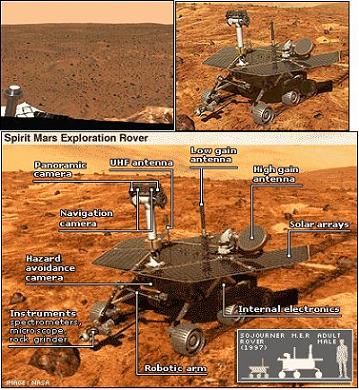Eli Ben David (translation)

Direct link to this page: https://www.hayadan.org.il/mosbauer1.html
The Mossbauer spectrometer is a key instrument on the Spirit. The device used to study minerals on Mars by NASA's rover could return confusing results, disrupting research to detect signs of water, experts say. It is known that the spectrometer will not be able to give an accurate distinction between minerals that were formed in the presence of water and those that were not.
But a senior scientist dismissed those claims and said the device was the best for the task. Details about this can be found in EARTH AND PLANETARY SCIENCE LETTERS.
The Mossbauer spectrometer instrument carried by NASA's twin rovers, Spirit and Opportunity, was designed to determine the mineral composition of rocks on the Red Planet's surface.
• * This will not allow us to distinguish between a mineral that contains hydrogen in its pattern and a mineral that does not, and this, of course, is the million dollar question * (M Darby Dyar, Mount Holyoake College)
But spectrometer expert Mosbauer told BBC News Online that the technique has limitations that could create difficulties in understanding the mineral data from Mars.
The question of the million dollars
Mission scientists will pay special attention to iron-containing minerals, because of its strong interaction with liquid water. But the lack of variety of ways in which iron interacts with different atoms in molecules can cause difficulties in translating Mossbauer measurements, said M Darby Dyar, associate professor of astronomy and geology at Mount Holyoake College, US.
On the other hand, NASA says that the Mossbauer spectrum is extremely accurate. "It won't allow us to distinguish between a mineral that has hydrogen in its pattern and a mineral that doesn't, which, of course, is the million dollar question," she said.
The presence of "iron hydroxides", for example, will clearly indicate the past presence of water on Mars.
But Dr. Goestar Klingelhoefer, head of NASA's rover team, responded: "(This paper) ignores many details we've already published. For example, Goethite (a mineral with a hydrogen effect [iron oxide]) in the Mossbaur spectrum has a special pattern.
Dr. Dyar: "It's especially bad if it's Fe3+, the oxidized form of iron - which we expect to find on Mars. The Mossbauer parameter range for this form of iron is extremely small, which means that almost anything with Fe3+ in it will look the same."
But Dr. Klingelhofer added that Dr. Dyar refers broadly to rare minerals that do not occur frequently in nature.
temperature change
The reddish soil of Mars is actually iron oxide. Basically she just rusted. This could have been caused more by an active interaction between an oxidizing atmosphere and a rocky surface, than past water activity.
In addition, Mössbauer spectra of minerals look different depending on the temperature of the specific mineral, she claims.
Martian temperatures range from approximately minus 133 degrees Celsius to plus 25 degrees Celsius (between 140 and 270 Kelvin). But Dr. Klinglehofer dismissed the claim, saying that the team had collected data on how temperature changes affect Mossbauer measurements on Mars, and that this information fed into the team's analyses.
"This is a fingerprint method," he said, "we can measure between daytime and nighttime, the entire temperature range, plus plus or minus 5 degrees (Celsius) - this will allow us to identify a mineral with the effect of hydrogen," he said.
Mossbauer's spectrometers work by bombarding the mineral being tested with gamma rays and measuring the atomic particles that do not recede.
Yadan Mars - current missions
For news at the BBC
https://www.hayadan.org.il/BuildaGate4/general2/data_card.php?Cat=~~~754990785~~~16&SiteName=hayadan
